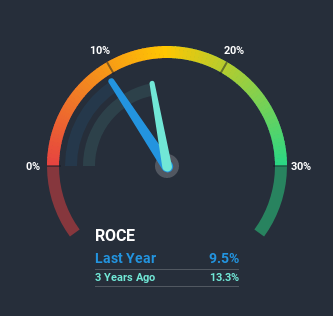
When researching a stock for investment, what can tell us that the company is in decline? A business that's potentially in decline often shows two trends, a return on capital employed (ROCE) that's declining, and a base of capital employed that's also declining. Ultimately this means that the company is earning less per dollar invested and on top of that, it's shrinking its base of capital employed. Having said that, after a brief look, Shiva Mills (NSE:SHIVAMILLS) we aren't filled with optimism, but let's investigate further.
What is Return On Capital Employed (ROCE)?
For those that aren't sure what ROCE is, it measures the amount of pre-tax profits a company can generate from the capital employed in its business. Analysts use this formula to calculate it for Shiva Mills:
Return on Capital Employed = Earnings Before Interest and Tax (EBIT) ÷ (Total Assets - Current Liabilities)
0.095 = ₹80m ÷ (₹1.2b - ₹394m) (Based on the trailing twelve months to December 2020).
Thus, Shiva Mills has an ROCE of 9.5%. Even though it's in line with the industry average of 8.7%, it's still a low return by itself.
View our latest analysis for Shiva Mills

Historical performance is a great place to start when researching a stock so above you can see the gauge for Shiva Mills' ROCE against it's prior returns. If you want to delve into the historical earnings, revenue and cash flow of Shiva Mills, check out these free graphs here.
What Can We Tell From Shiva Mills' ROCE Trend?
In terms of Shiva Mills' historical ROCE movements, the trend doesn't inspire confidence. Unfortunately the returns on capital have diminished from the 13% that they were earning three years ago. Meanwhile, capital employed in the business has stayed roughly the flat over the period. Companies that exhibit these attributes tend to not be shrinking, but they can be mature and facing pressure on their margins from competition. If these trends continue, we wouldn't expect Shiva Mills to turn into a multi-bagger.
On a related note, Shiva Mills has decreased its current liabilities to 32% of total assets. So we could link some of this to the decrease in ROCE. Effectively this means their suppliers or short-term creditors are funding less of the business, which reduces some elements of risk. Some would claim this reduces the business' efficiency at generating ROCE since it is now funding more of the operations with its own money.
What We Can Learn From Shiva Mills' ROCE
In summary, it's unfortunate that Shiva Mills is generating lower returns from the same amount of capital. And long term shareholders have watched their investments stay flat over the last year. That being the case, unless the underlying trends revert to a more positive trajectory, we'd consider looking elsewhere.
Shiva Mills does come with some risks though, we found 3 warning signs in our investment analysis, and 2 of those shouldn't be ignored...
While Shiva Mills isn't earning the highest return, check out this free list of companies that are earning high returns on equity with solid balance sheets.
When trading Shiva Mills or any other investment, use the platform considered by many to be the Professional's Gateway to the Worlds Market, Interactive Brokers. You get the lowest-cost* trading on stocks, options, futures, forex, bonds and funds worldwide from a single integrated account. Promoted
New: Manage All Your Stock Portfolios in One Place
We've created the ultimate portfolio companion for stock investors, and it's free.
• Connect an unlimited number of Portfolios and see your total in one currency
• Be alerted to new Warning Signs or Risks via email or mobile
• Track the Fair Value of your stocks
This article by Simply Wall St is general in nature. It does not constitute a recommendation to buy or sell any stock, and does not take account of your objectives, or your financial situation. We aim to bring you long-term focused analysis driven by fundamental data. Note that our analysis may not factor in the latest price-sensitive company announcements or qualitative material. Simply Wall St has no position in any stocks mentioned.
*Interactive Brokers Rated Lowest Cost Broker by StockBrokers.com Annual Online Review 2020
Have feedback on this article? Concerned about the content? Get in touch with us directly. Alternatively, email editorial-team (at) simplywallst.com.
About NSEI:SHIVAMILLS
Shiva Mills
Engages in the manufacturing and marketing of cotton yarns in India.
Excellent balance sheet very low.
Market Insights
Community Narratives




